Okay, so the other day, the power went out. Total darkness. And I was like, “Oh great, what now?” I fumbled around for my phone, turned on the flashlight, and realized I needed a better plan for next time. Thus began my journey to build a power cut emergency kit.
Getting Started: The Basics
First, I grabbed a sturdy box I had lying around. Any container will do, really, as long as it’s big enough and easy to find in the dark. A backpack, duffel bag, or even a clearly labeled plastic bin works.

Then, I started gathering the essentials. The most obvious thing? Light. I rounded up a few different things:
- A couple of those LED flashlights – the ones that take AA or AAA batteries. I made sure to have extra batteries, too. No point in a flashlight if it dies on you.
- Some of those battery-powered LED candles. They’re way safer than real candles, and they give off a nice, calming glow.
- A headlamp! I know, I know, it looks dorky, but seriously, it’s a lifesaver when you need both hands free.
Keeping in Touch and Staying Informed
Next, I thought about staying connected. My phone’s great, but what if the cell towers are down? So, I added these to the kit:
- A powerbank. This is to charge the phone.
- A basic, battery-powered radio. The kind that gets AM/FM. It might sound old-school, but it’s the best way to get updates during a big outage.
- I even wrote down a few important phone numbers on a piece of paper. Just in case my phone completely died.
Comfort and First Aid
Then, I thought about basic comfort. If you’re stuck for a while, you want to be somewhat comfortable, right? So, into the box went:
- A few blankets. Nothing fancy, just some fleece throws to keep warm.
- Bottled water. Always a good idea to have some on hand.
- Some non-perishable snacks. Granola bars, crackers, that sort of thing. Stuff that doesn’t need to be cooked or refrigerated.
- A basic first-aid kit. Band-aids, antiseptic wipes, pain relievers. You never know.
Putting It All Together And Test!
Finally, I packed everything neatly into the box. I made sure the most important things, like the flashlights, were on top and easy to grab. I put the box in a place I could easily find it, even in the dark – under the stairs.
I even tested it, I turned the light off and found that the box I used before was difficult to find.
So I changed it to another bright color box.
Now, I feel way more prepared. It’s not about being paranoid; it’s about being practical. A little preparation can make a big difference when the lights go out.



